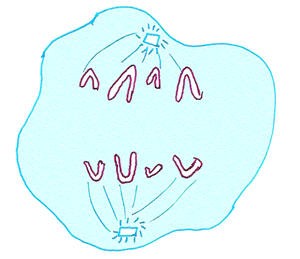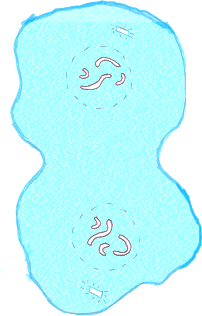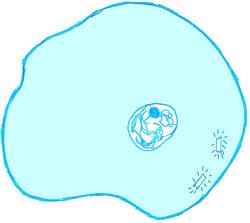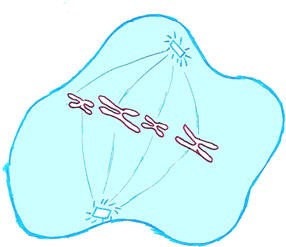Mitosis And The Cell Cycle

Quiz over celluar mitosis and the cell cycle. To be used as a review for chapter test 8 in the Biology: Dynamics of Life textbook.
- 1.
Identify the phase of mitosis shown in this diagram.
- A.
Prophase
- B.
Metaphase
- C.
Anaphase
- D.
Telophase
- E.
Cytokinesis
Correct Answer
C. AnaphaseExplanation
Anaphase is the phase of mitosis where the sister chromatids of each chromosome separate and move towards opposite poles of the cell. This diagram likely shows this phase because it depicts the chromosomes being pulled apart and moving away from each other. The other phases of mitosis, such as prophase, metaphase, and telophase, have different characteristics that are not evident in the given diagram. Cytokinesis, on the other hand, is the division of the cytoplasm and is a separate process that occurs after mitosis.Rate this question:
-
- 2.
Identify the phase of mitosis shown in this diagram.
- A.
Prophase
- B.
Metaphase
- C.
Anaphase
- D.
Telophase
- E.
Cytokinesis
Correct Answer
D. TelophaseExplanation
The correct answer is telophase. Telophase is the final stage of mitosis where the chromosomes have reached opposite poles of the cell and begin to decondense. During this phase, a nuclear envelope starts to form around each set of chromosomes, and the nucleolus reappears. Additionally, the spindle fibers disassemble, and cytokinesis, the division of the cytoplasm, begins.Rate this question:
-
- 3.
Identify the phase of mitosis shown in this diagram.
- A.
Prophase
- B.
Metaphase
- C.
Anaphase
- D.
Telophase
- E.
Interphase
Correct Answer
A. ProphaseExplanation
The correct answer is prophase. In prophase, the chromosomes condense and become visible, the nuclear membrane begins to break down, and the spindle fibers start to form. This diagram likely shows these characteristics, indicating that the cell is in the prophase stage of mitosis.Rate this question:
-
- 4.
Identify the phase of mitosis shown in this diagram.
- A.
Prophase
- B.
Metaphase
- C.
Anaphase
- D.
Telophase
- E.
Interphase
Correct Answer
E. InterphaseExplanation
The given diagram does not show any visible chromosomes or cell division occurring. Interphase is the phase of the cell cycle where the cell prepares for division by growing, replicating its DNA, and conducting normal cellular functions. Since the diagram does not show any signs of cell division, it is most likely representing the interphase stage.Rate this question:
-
- 5.
Identify the phase of mitosis shown in this diagram.
- A.
Prophase
- B.
Metaphase
- C.
Anaphase
- D.
Telophase
- E.
Cytokinesis
Correct Answer
E. CytokinesisExplanation
The diagram represents the phase of mitosis where the cytoplasm divides, separating the two daughter cells. This phase is known as cytokinesis, which occurs after the completion of telophase. During cytokinesis, a cleavage furrow forms in animal cells or a cell plate forms in plant cells, leading to the separation of the cytoplasm and the formation of two distinct daughter cells.Rate this question:
-
- 6.
Identify the phase of mitosis shown in this diagram.
- A.
Prophase
- B.
Metaphase
- C.
Anaphase
- D.
Telophase
- E.
Interphase
Correct Answer
B. MetaphaseExplanation
The correct answer is metaphase. In metaphase, the chromosomes align along the equatorial plane of the cell, forming a single line called the metaphase plate. This diagram shows a clear alignment of chromosomes in a single line, indicating that it is in the metaphase stage of mitosis.Rate this question:
-
- 7.
Identify the phase of mitosis shown in this diagram.
- A.
Prophase
- B.
Metaphase
- C.
Anaphase
- D.
Telophase
- E.
Interphase
Correct Answer
E. InterphaseExplanation
The diagram shown does not depict any of the phases of mitosis, but rather the interphase. Interphase is the phase in the cell cycle where the cell prepares for division by growing, replicating its DNA, and undergoing normal cellular functions. It is not a phase of mitosis, but rather the phase that precedes it.Rate this question:
-
- 8.
Tightly coiled DNA is referred to as
- A.
Chromatin
- B.
Chromatids
- C.
Chromosomes
- D.
Chromobodies
Correct Answer
C. ChromosomesExplanation
Tightly coiled DNA is referred to as chromosomes. Chromosomes are structures that contain DNA and are found in the nucleus of cells. They are formed when DNA coils tightly around proteins called histones. Chromosomes are responsible for carrying genetic information and are visible under a microscope during cell division.Rate this question:
-
- 9.
Sister chromatids separate during
- A.
Prophase
- B.
Metaphase
- C.
Anaphase
- D.
Telophase
- E.
Interphase
Correct Answer
C. AnaphaseExplanation
During anaphase, sister chromatids separate and move towards opposite poles of the cell. This is facilitated by the contraction of spindle fibers attached to the centromeres of the sister chromatids. As the spindle fibers shorten, the sister chromatids are pulled apart and towards the opposite ends of the cell. This ensures that each resulting daughter cell receives a complete set of chromosomes. Therefore, anaphase is the correct answer as it specifically describes the process of sister chromatid separation.Rate this question:
-
- 10.
The sister chromatids are held together by the
- A.
Centrioles
- B.
Centromeres
- C.
Centrosomes
- D.
Centrochores
Correct Answer
B. CentromeresExplanation
The sister chromatids are held together by the centromeres. The centromere is a specialized region on the chromosome where the two sister chromatids are joined together. It plays a crucial role in ensuring accurate segregation of the chromosomes during cell division. The centromere contains specific DNA sequences and proteins that form a structure called the kinetochore, which attaches to the spindle fibers during cell division. This attachment allows the sister chromatids to be pulled apart and distributed to the daughter cells. Therefore, the correct answer is centromeres.Rate this question:
-
- 11.
Mitosis is
- A.
The process of cell growth and division
- B.
The division of the cytoplasm
- C.
The division of the nuclear material
- D.
All of these
Correct Answer
C. The division of the nuclear materialExplanation
Mitosis is the process of cell division where the nuclear material, including the DNA, is divided equally into two daughter cells. This ensures that each daughter cell receives the same genetic information as the parent cell. During mitosis, the chromosomes condense, align at the center of the cell, and then separate into two sets, each going to opposite poles of the cell. Finally, the cell membrane pinches inward, dividing the cytoplasm and creating two separate cells. Therefore, the correct answer is "the division of the nuclear material."Rate this question:
-
- 12.
The cell spends most of its time in which phase of the cell cycle?
- A.
G1
- B.
G2
- C.
S
- D.
Mitosis
- E.
Cytokinesis
Correct Answer
A. G1Explanation
During the G1 phase of the cell cycle, the cell grows and carries out its normal functions. This phase is also known as the gap phase, as it occurs after cell division and before DNA replication. The cell spends the majority of its time in the G1 phase, preparing for DNA synthesis in the S phase. Once the cell completes the G1 phase, it can either enter the S phase to replicate its DNA or exit the cell cycle and enter a non-dividing state called G0.Rate this question:
-
- 13.
- A.
Centrioles
- B.
Centromeres
- C.
Centrosomes
- D.
Centrochores
Correct Answer
B. Centromeres -
- 14.
The structures found only in animal cells which organize the spindle fibers and is only seen just before cell division are
- A.
Centrioles
- B.
Centromeres
- C.
Centrosomes
- D.
Centrochores
Correct Answer
A. CentriolesExplanation
Centrioles are the correct answer because they are structures found only in animal cells that organize the spindle fibers. They are responsible for forming the mitotic spindle during cell division, which helps in the separation of chromosomes. Centrioles are usually located near the nucleus and are composed of microtubules. They play a crucial role in cell division and are not present in plant cells.Rate this question:
-
- 15.
The cell spends most of its time in which phase of the cell cycle?
- A.
G1
- B.
G2
- C.
S
- D.
Mitosis
- E.
Cytokinesis
Correct Answer
A. G1Explanation
During the G1 phase of the cell cycle, the cell grows and carries out its normal functions. It prepares for DNA replication by synthesizing proteins and accumulating energy reserves. This phase is also known as the gap phase. It is the longest phase of the cell cycle and the cell spends most of its time in this phase before proceeding to the S phase, where DNA replication occurs. Therefore, the cell spends most of its time in the G1 phase.Rate this question:
-
- 16.
Duplication of the DNA occurs in which of the following phases?
- A.
Prophase
- B.
S stage of interphase
- C.
G1 stage of interphase
- D.
G2 stage of interphase
- E.
Anaphase
Correct Answer
B. S stage of interphaseExplanation
During the S stage of interphase, which is the synthesis phase, DNA replication occurs. This is the phase where the cell prepares for cell division by duplicating its DNA. Therefore, the correct answer is S stage of interphase.Rate this question:
-
- 17.
The
- A.
Centrioles
- B.
Centromeres
- C.
Centrosomes
- D.
Centrochores
Correct Answer
A. Centrioles -
- 18.
The spindle fibers connect to the centromeres during which pahse of mitosis?
- A.
Prophase
- B.
Metaphase
- C.
Anaphase
- D.
Telophase
- E.
Interphase
Correct Answer
B. MetaphaseExplanation
During metaphase of mitosis, the spindle fibers connect to the centromeres. This is the stage where the chromosomes line up along the equator of the cell and are attached to the spindle fibers via their centromeres. The spindle fibers play a crucial role in separating the sister chromatids during anaphase, ensuring that each daughter cell receives the correct number of chromosomes. Therefore, metaphase is the correct phase of mitosis in which the spindle fibers connect to the centromeres.Rate this question:
-
- 19.
Duplication of the DNA occurs in which of the following phases?
- A.
Prophase
- B.
S stage of interphase
- C.
G1 stage of interphase
- D.
G2 stage of interphase
- E.
Anaphase
Correct Answer
B. S stage of interphaseExplanation
During the S stage of interphase, DNA replication takes place. This is when the cell prepares to divide and duplicates its DNA. The DNA strands unwind and separate, and each strand serves as a template for the synthesis of a new complementary strand. This ensures that each daughter cell receives an identical copy of the genetic material during cell division. Therefore, the correct answer is the S stage of interphase.Rate this question:
-
- 20.
Each half of the duplicated DNA is called a
- A.
Chromosome
- B.
Chromatin
- C.
Chromatid
- D.
Chromochore
Correct Answer
C. ChromatidExplanation
A chromatid is one of the two identical copies of a chromosome that are joined together by a centromere. During cell division, each chromatid is separated and distributed to the daughter cells, ensuring that each new cell receives a complete set of genetic information. Therefore, each half of the duplicated DNA is referred to as a chromatid. Chromosome refers to the entire structure made up of two chromatids, while chromatin is the material that makes up chromosomes and contains DNA and proteins. Chromochore is not a recognized term in the context of DNA or chromosomes.Rate this question:
-
- 21.
One reason cells must remain small because the surface area increases ____________ than the volume.
Correct Answer
slowerExplanation
Cells must remain small because the surface area increases slower than the volume. As a cell grows in size, its volume increases at a faster rate than its surface area. This is because volume is determined by the cube of the cell's dimensions, while surface area is determined by the square of the cell's dimensions. If a cell becomes too large, its surface area may not be sufficient to support the exchange of nutrients, gases, and waste products with its environment. Therefore, cells need to stay small to ensure efficient and effective cellular functions.Rate this question:
- 22.
The spindle fibers connect to the centromeres during which phase of mitosis?
- A.
Prophase
- B.
Metaphase
- C.
Anaphase
- D.
Telophase
- E.
Interphase
Correct Answer
B. MetaphaseExplanation
During metaphase of mitosis, the spindle fibers connect to the centromeres. This is the stage where the chromosomes align along the equatorial plane of the cell, forming a single line called the metaphase plate. The spindle fibers, which are made up of microtubules, attach to the centromeres of each chromosome, ensuring that they are properly aligned and ready for separation during anaphase. Therefore, metaphase is the correct phase of mitosis during which the spindle fibers connect to the centromeres.Rate this question:
-
- 23.
Each half of the duplicated DNA is called a
- A.
Chromosome
- B.
Chromatin
- C.
Chromatid
- D.
Chromochore
Correct Answer
C. ChromatidExplanation
A chromatid is one of the two identical copies of a duplicated chromosome. During cell division, each chromatid is separated and distributed to the daughter cells, ensuring that each cell receives a complete set of genetic information. Therefore, a chromatid refers to each half of the duplicated DNA, making it the correct answer.Rate this question:
-
- 24.
If the size of the cell is doubled, the volume increases _______ times more than the surface area.
Correct Answer
8
eightExplanation
When the size of the cell is doubled, the volume increases 8 times more than the surface area. This is because the volume of a cell is directly proportional to the cube of its size, while the surface area is directly proportional to the square of its size. Therefore, when the size is doubled, the volume will increase by a factor of 2^3 = 8, while the surface area will only increase by a factor of 2^2 = 4.Rate this question:
- 25.
Mitosis is important because it
- A.
Creates tissues
- B.
Replaces dead or damaged cells
- C.
Allows organisms to grow
- D.
Ensures each new generation is identical to the parent
- E.
All of these
Correct Answer
E. All of theseExplanation
Mitosis is the process of cell division that allows organisms to grow, replace dead or damaged cells, and create new tissues. It ensures that each new generation of cells is identical to the parent cells. Therefore, all of the given options are correct explanations for why mitosis is important.Rate this question:
-
Quiz Review Timeline +
Our quizzes are rigorously reviewed, monitored and continuously updated by our expert board to maintain accuracy, relevance, and timeliness.
-
Current Version
-
Mar 20, 2023Quiz Edited by
ProProfs Editorial Team -
Feb 26, 2010Quiz Created by
Mrsholm
 Back to top
Back to top







